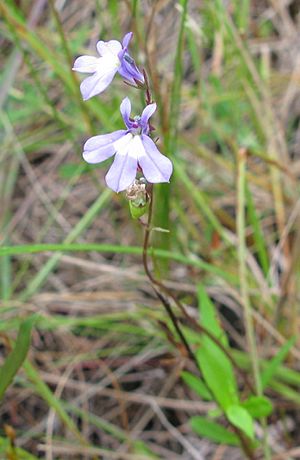Lobelia kalmii facts for kids
Quick facts for kids Lobelia kalmii |
|
|---|---|
 |
|
| Lobelia kalmii | |
| Conservation status | |
| Scientific classification | |
| Genus: |
Lobelia
|
| Species: |
kalmii
|
Lobelia kalmii is a type of flowering plant that grows mostly across Canada and the northern United States. It likes cooler, northern areas known as temperate and boreal regions. This plant used to be called Lobelia strictiflora. It has a few common names, like Kalm's lobelia, Ontario lobelia, and Brook lobelia.
Contents
Where Does Kalm's Lobelia Grow?
Lobelia kalmii is a small plant, usually growing about 10 to 40 centimeters tall. It loves wet places! You can often find it in bogs (wet, spongy areas), damp meadows, and along rocky shorelines. It also grows in special places called wet alvars, which are open areas with thin soil over limestone rock. This plant prefers soil that has a lot of calcium (like chalk or seashells), or it grows right in the cracks of limestone rocks.
What Does Kalm's Lobelia Look Like?
This plant has pretty blue flowers with a white center. Each flower is quite small, about 1 centimeter across. Its leaves are interesting too: the ones higher up on the stem are thin, while the leaves at the bottom (called basal leaves) are shaped like a spatula. Lobelia kalmii starts to bloom in July and keeps flowering all the way into September.
Why Isn't Kalm's Lobelia a Garden Favorite?
Even though many other types of Lobelia plants are grown in gardens because they are so pretty, Lobelia kalmii isn't usually chosen for ornamental purposes. This is mainly because its flowers are quite small. However, people who really love native plants often trade seeds of Lobelia kalmii. It's a tough plant and can even grow in unexpected places, like scattered around rock gardens near house downspouts!
How Was Kalm's Lobelia Used in the Past?
Long ago, Native Americans used different types of Lobelia plants for traditional medicine. They used them to help with breathing problems and muscle issues. They also used them as a cleansing medicine. The most common type of Lobelia used in modern herbalism today is Lobelia inflata, also known as Indian Tobacco.


